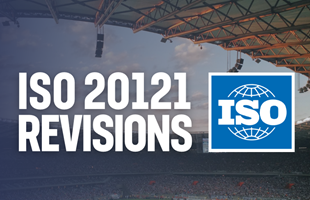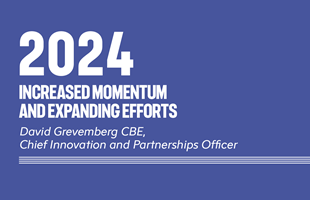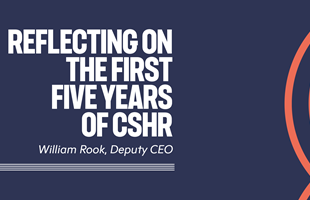
The Centre for Sport and Human Rights Starts its Engines as an Independent Entity - After Years in the Making
This blog has also been published by the Institute for Human Rights and Business.
On 8 July 2021, the Centre for Sport and Human Rights (CSHR) fully separated from its founding body The Institute for Human Rights and Business (IHRB), becoming a standalone legal entity under Swiss law with a new board of independent Directors. As this important transition takes shape, CSHR’s CEO, Mary Harvey, and John Morrison, CEO of IHRB, reflect back on the journey so far, and on the work ahead.
It all started at the backend of the London 2012 Olympics. The Chair of the event’s Sustainability Commission, Shaun McCarthy, came to IHRB with a problem. His Commission had gathered a lot of environmental and social learning over its lifespan but what would be its legacy?
There were conduits for transferring London’s environmental lessons to the International Olympic Committee (IOC) and the Rio 2016 Games, but no one was that interested in the Commission’s social learning – in particular the human rights focus of London 2012 and its supply chain. Ironically, at the same time, the UK, Russian, South Korean and Brazilian Governments issued a joint communique, instigated by then UK Foreign Secretary William Hague, committing these upcoming Summer and Winter Olympics hosts to respect human rights.
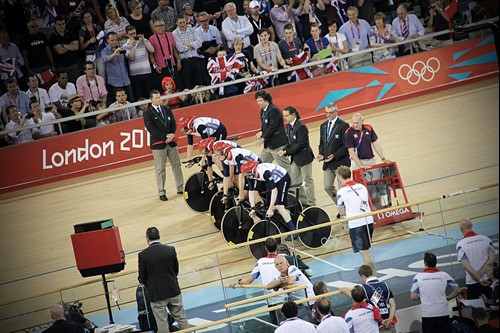
Image: London 2012 Olympic Games (Simon Connellan)
How could sustainability knowledge be transferred between events and across sporting traditions, instead of the "Groundhog Day” scenario of each learning from scratch? This resonated with ideas from the Australian human rights community and its conference ahead of the 2000 Sydney Olympics (and a bottle of whisky that Patrick Earle and John Morrison shared in a hotel in Chang Mai, Thailand, in 2003 – but that’s another story).
IHRB Research Fellow Lucy Amis, now a Senior Advisor at CSHR, gets much of the credit for what happened next. With support from the British Government, Lucy trawled through reports relating to previous mega-sporting events as well as preparations for the 2014 FIFA World Cup in Brazil and Rio 2016. The result was ‘Striving for Excellence’, a foundational IHRB report published in late 2013 that made the case for how things could be different – how the world of sport could understand and address its human rights impacts and learn from others. That meant, in particular, showing that the UN Guiding Principles on Business and Human Rights were a critical framework that applied to sport.
The research from Brazil suggested that far from cooperating on human rights issues – such as the conditions of construction workers (including 9 fatalities in the run up to the 2014 FIFA World Cup), on a range of rights issues from freedom of expression, to extra-judicial killings, forced displacements and ethical procurement, sports governing bodies were working in silos. IHRB’s report was read by NGOs, trade unions as well as some of the major international sponsors and broadcasters. Sports bodies also took note: the Glasgow 2014 Commonwealth Games become the first major event to have a dedicated human rights policy.
A 2014 letter from IHRB to FIFA (signed by Mary Robinson and John Ruggie, then Patron and Chair of IHRB respectively) highlighted the relevance of the IHRB report recommendations for the FIFA’s work and urged action. This jumpstarted FIFA’s own human rights journey, which led them to commission an important report by John Ruggie, published in 2016.
Around the same time, IHRB started preparations for a meeting that was eventually held in Glion, Switzerland in late 2015, with the support of Wilton Park (an agency of the UK Government) and the Government of Switzerland (key, given the location of many sports body headquarters). It brought together a diverse group of 40 or so governments, sponsors, broadcasters, UN agencies, trade unions, NGOs and experts.
The central question: How could all those concerned with improving the human rights performance of sport work together to achieve common goals, in particular on pressing issues of large events? Participants had their own track records on sport and human rights, but many felt there were better ways to work together, and that a business and human rights approach could move the needle.
The Glion event saw the birth of the Mega-Sporting Events Platform for Human Rights
(MSE Platform), supported from day one by key partners at the OHCHR, ILO, ITUC and IOE, who continue today as custodians of the Centre. As well as the Olympic Games in Rio 2016, a big focus of this multi-stakeholder group involved the conditions of migrant workers building stadiums for Qatar 2022 – work led for IHRB by William Rook, now CSHR’s Deputy CEO.
Multi-stakeholder processes require focus and momentum, and in 2016 the US State Department hosted the first “Sporting Chance Forum” to bring together the wider community of interests surrounding the MSE Platform. The “Sporting Chance Principles” were adopted and have since become the bedrock for the sports and human rights movement. A series of white papers, written by a diversity of strategic partners and driven for the MSE Platform by William Rook and Haley St. Dennis in 2017, built the evidence base and started to model practical actions that a new organisation could lead to promote human rights throughout the world of sport.
One thing became clearer during 2017 and 2018: human rights challenges facing sport (including the abuse of women and child athletes) ran deeper than events themselves – they were systemic in day-to-day sport and were not being adequately addressed. The very “autonomy” of sport – an important principle to avoid political interference from governments – had become synonymous with a lack of accountability and corruption.

Image: Mary Robinson launches the Centre for Sport and Human Rights
And so, building on commitments made in 2017, the nearly 40 members of the MSE Platform committed to supporting a permanent and independent “Centre for Sport and Human Rights” with a broad mandate. The Centre was officially launched in June 2018, initially as a subsidiary of IHRB, and appointed its first Chief Executive in late 2018.
Over the past three years the Centre has set about building an organisation with strong leadership and a life of its own. In 2019 it began a period of “storming and forming”, to see what this unique organisation was capable of achieving. Right off the bat, in January 2019, the Centre convened stakeholders around the detention of Hakeem Al Araibi, an Australian resident, footballer and Bahraini refugee, who had been arrested in Thailand while on his honeymoon on an incorrect Interpol Red Notice. Six weeks later, after unprecedented collective action by governments, sport bodies, civil society, and human rights activists, Hakeem was released and safely returned to Australia. Not only was it euphoric news for all who worked for his release, it was also indelible evidence that collective action worked.
The Centre has continued to convene its Advisory Council and other actors on difficult cases and issues in sport where human rights are at stake, including egregious athlete and child abuse in Afghanistan and Haiti, the impact of Covid-19, protecting athlete voice and advocacy, and supporting labour reforms in Qatar.
The Centre also continued to engage mega-sporting event hosts in preventing and mitigating risks, including through robust multi-stakeholder working groups, and deep dives into key areas, such as freedom of expression and labour rights. This work has proved to be a rich and efficient way for host actors and event sponsors to identify not only risks, but also opportunities to create positive human rights legacies for these events.
Over 40 sports bodies attended the 2019 Sporting Chance Forum, held at the Palais des Nations in Geneva, kick starting greater in-depth work with sports bodies, raising awareness on human rights risks and opportunities and helping build capacity to enable a greater focus on impacts to people.
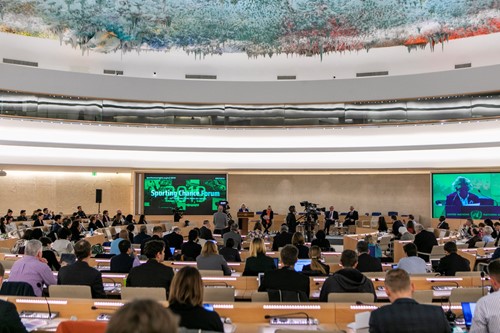
Image: Sporting Chance Forum 2019
To build capacity in critical areas, the Centre bolstered its leadership team and engagement expertise, and recruited subject matter experts in several areas including child rights, safeguarding, remedy and gender, bringing this expertise is brought to bear in work with sports bodies and major events. Significant investments were made in digital engagement, running webinars on athlete abuse and athlete activism, launching the Sport and Rights podcast series, relaunching the brand and website, and increasingly engaging on social media.
As the Centre has grown and learned, it incorporated those learnings into what lies ahead. Its new strategic plan, that will launch this September, will outline plans over the next four years to bring human rights and the world of sport together in ways that better prevent harms and create shared value.
Now, as the Centre for Sport and Human Rights launches as a fully independent organisation and takes its place in Geneva, the home of the international human rights community, it does so on firm footing and a clear sense of purpose, led by a diverse, experienced, and committed Board of Directors. In the months ahead, we look forward to growing our now 49 member- strong Advisory Council and catalysing the broader sport and human rights movement to greater heights.
